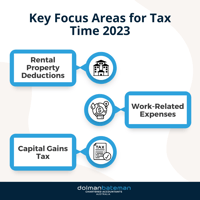The Australian Taxation Office (ATO) has identified three key focus areas for Tax Time 2023: rental...
Application for Suppression of Residential Addresses: Changes and Implications

Ensuring the privacy and security of individuals has become a pressing concern. The need for protecting residential addresses has led to the introduction of an application process for suppressing such information with ASIC.
The Need for Residential Address Suppression
Australia, like many countries, recognises the importance of safeguarding the privacy of its citizens. Residential addresses, being an integral part of an individual's personal information, have become vulnerable to abuse, stalking, identity theft, and other forms of harassment. To address these concerns, Australia has implemented measures to allow individuals to apply for the suppression of their residential address from public records.
Changes to Suppressed Addresses
In recent times, Australia has undergone some significant changes to its suppressed address system. Previously, suppressed addresses were completely hidden from public records, making it challenging for certain legitimate entities to verify a person's residency or carry out essential functions, such as providing government services or contacting individuals for official matters.
To strike a balance between privacy and functional requirements, Australia has introduced a refined approach. Under the new system, suppressed addresses are not entirely invisible but replaced with a generic locality, such as a suburb or city, making it easier for authorised organizations to establish a person's residency while still protecting their precise location.
How to make an application
Step 1: If your name and address are on the Australian electoral roll
-
- Complete the Application for Suppression of Residential Address (Form 379).
- Provide your full name, date of birth, and place of birth.
- Specify your usual residential address, which will be suppressed from the public database.
- Indicate your alternative address, which will be displayed in place of your residential address.
- Remember to attach a copy of the Australian Electoral Commission (AEC) approval letter confirming your 'silent enrolment' status.
- Complete the Application for Suppression of Residential Address (Form 379).
Step 2: If your name is not on the Australian electoral roll
-
- Lodge an Application to Use an Alternative Address (Form 378).
- Pay the application fee of $44 for the Application to Use an Alternative Address (Form 378).
- Accompany the Application to Use an Alternative Address (Form 378) with a statutory declaration.
- Provide a detailed explanation outlining the reasons why your personal safety or that of your family members is at risk.
- Complete the Application for Suppression of Residential Address (Form 379).
- Follow the same requirements mentioned in Step 1, excluding the need for the AEC's approval letter in this situation.
- Lodge an Application to Use an Alternative Address (Form 378).
Once ASIC has granted approval/making changes to a suppressed address
-
- Receiving the ASIC Approval Number: Upon approval of your application, ASIC will issue a notice containing your unique ASIC approval number. This number serves as a reference for your suppressed address and is vital for future correspondence with ASIC.
- Approval notification: Once ASIC has reviewed your application and reached a decision, they will inform you of the outcome. If approved, you will receive notification detailing the changes made to your suppressed address.

This blog has been prepared for the purposes of general information and guidance only. It should not be used for specific advice or used for formulating decisions under any circumstances. If you would like specific advice about your own personal circumstances, please feel free to contact us on 02 9411 5422. We can help make sure the right method is used to give you the maximum possible tax deduction associated with any of these methods.


